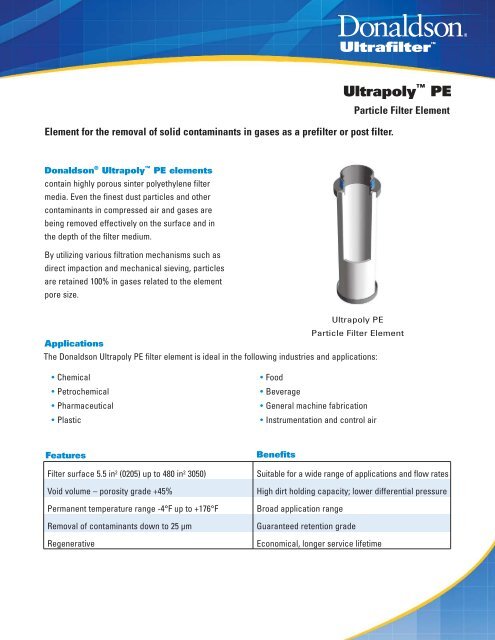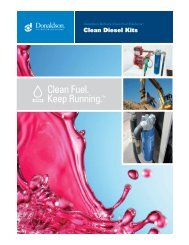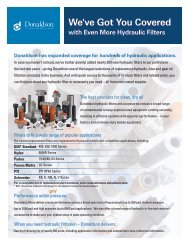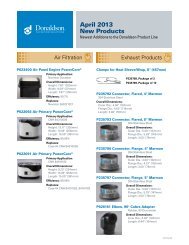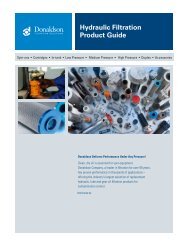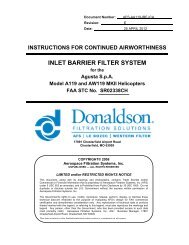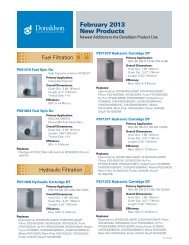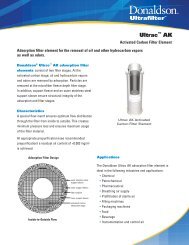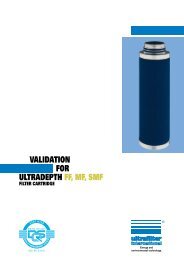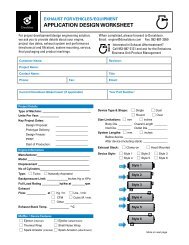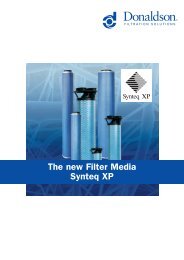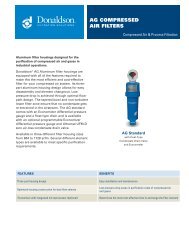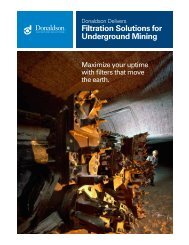Ultrapoly PE.qxd - Donaldson Company, Inc.
Ultrapoly PE.qxd - Donaldson Company, Inc.
Ultrapoly PE.qxd - Donaldson Company, Inc.
Create successful ePaper yourself
Turn your PDF publications into a flip-book with our unique Google optimized e-Paper software.
Element for the removal of solid contaminants in gases as a prefilter or post filter.<br />
<strong>Ultrapoly</strong> <strong>PE</strong><br />
Particle Filter Element<br />
<strong>Donaldson</strong> ® <strong>Ultrapoly</strong> <strong>PE</strong> elements<br />
contain highly porous sinter polyethylene filter<br />
media. Even the finest dust particles and other<br />
contaminants in compressed air and gases are<br />
being removed effectively on the surface and in<br />
the depth of the filter medium.<br />
By utilizing various filtration mechanisms such as<br />
direct impaction and mechanical sieving, particles<br />
are retained 100% in gases related to the element<br />
pore size.<br />
<strong>Ultrapoly</strong> <strong>PE</strong><br />
Particle Filter Element<br />
Applications<br />
The <strong>Donaldson</strong> <strong>Ultrapoly</strong> <strong>PE</strong> filter element is ideal in the following industries and applications:<br />
• Chemical<br />
• Petrochemical<br />
• Pharmaceutical<br />
• Plastic<br />
• Food<br />
• Beverage<br />
• General machine fabrication<br />
• Instrumentation and control air<br />
Features<br />
Filter surface 5.5 in 2 (0205) up to 480 in 2 3050)<br />
Void volume – porosity grade +45%<br />
Permanent temperature range -4°F up to +176°F<br />
Removal of contaminants down to 25 μm<br />
Regenerative<br />
Benefits<br />
Suitable for a wide range of applications and flow rates<br />
High dirt holding capacity; lower differential pressure<br />
Broad application range<br />
Guaranteed retention grade<br />
Economical, longer service lifetime
<strong>Ultrapoly</strong> <strong>PE</strong><br />
Specifications<br />
Retention Rate<br />
Maximum Differential<br />
Pressure:<br />
100% in gases; defined rate of<br />
particles larger than the pore size<br />
30 psi at 68°F regardless<br />
of system pressure<br />
Materials<br />
Filter Media<br />
Bonding<br />
Pure high molecular polyethylene<br />
Epoxy resin<br />
Initial Differential Pressure<br />
at Nominal Flow<br />
0.44 psi<br />
End Caps<br />
Two O-Rings<br />
Aluminum<br />
Perbunan ® *: silicone free and free<br />
of parting compound (standard)<br />
Pressure Drop Calculations<br />
Performance of <strong>PE</strong> elements — compressed air<br />
These curves define the flow of a 1030 filter element at<br />
standard conditions (14.7 psia; 68°F; R.H.= 70%)<br />
Element<br />
Size<br />
Correction Factor<br />
Filter Surface<br />
C F<br />
0205 0.08<br />
0305 0.10<br />
0310 0.12<br />
0410 0.17<br />
0420 0.19<br />
0520 0.25<br />
0525 0.32<br />
0725 0.47<br />
0730 0.68<br />
1030 1.00<br />
1530 1.55<br />
2030 2.10<br />
3030 3.20<br />
3050 5.65<br />
Volume Flow (scfm)<br />
70<br />
60<br />
50<br />
40<br />
30<br />
20<br />
10<br />
0 0.1 0.2 0.3 0.4 0.5 0.6<br />
Differential Pressure (psi)<br />
The performance curve is based on 1030 element, or one ten inch<br />
equivalent (TIE), and the correction factor for filter surface C f for a<br />
1030 = 1.00.<br />
Example 1: Low Flow Single Element<br />
Given:<br />
• Flow rate = 12 scfm<br />
• Pressure = 80 psig<br />
• Using AG0002 (1–0205 <strong>PE</strong> Element)<br />
1. Convert flow given from standard cubic feet per minute<br />
to actual cubic feet per minute<br />
• 12 scfm x (14.7 psia / 94.7 psia) = 1.86 acfm<br />
(through the housing and element)<br />
2. Divide by the correction factor<br />
• 1.86 / 0.08 = 23.25 acfm (through each TIE)<br />
3. Pressure drop through this element = 0.29 psid<br />
Example 2: High Flow Multiple Element<br />
Given:<br />
• Flow rate = 15,000 scfm<br />
• Pressure = 150 psig<br />
• Using SH2200 (27 - 3030 <strong>PE</strong> Element)<br />
1. Convert flow given from standard cubic feet per minute<br />
to actual cubic feet per minute<br />
• 15,500 scfm x (14.7 psia / 164.7 psia) = 1,383 acfm<br />
(through the housing)<br />
2. Divide by number of elements<br />
• 1,383 / 27 = 51.2 acfm (through each element)<br />
3. Divide by correction factor<br />
• 51.2 / 3.20 = 16 acfm (through each TIE)<br />
4. Pressure drop through these elements = 0.125 psid<br />
* Perbunan ® is a registered trademark of LANXESS Deutschland GmbH.<br />
açå~äÇëçå=`çãé~åóI=fåÅK<br />
`çãéêÉëëÉÇ=^áê=C=d~ë<br />
mKlK=_çñ=NOVV<br />
jáååÉ~éçäáëI=jk<br />
RRQQMJNOVV=rKpK^K<br />
qÉä UMMKRQPKPSPQ=Erp^F<br />
qÉä UMMKPQPKPSPV=EïáíÜáå=jÉñáÅçF<br />
c~ñ TTMKQQUKPURQ<br />
ÅçãéêÉëëÉÇ~áê]Ççå~äÇëçåKÅçã<br />
Ççå~äÇëçåKÅçã<br />
fåÑçêã~íáçå=áå=íÜáë=ÇçÅìãÉåí<br />
áë=ëìÄàÉÅí=íç=ÅÜ~åÖÉ=ïáíÜçìí=åçíáÅÉK<br />
«=OMMV=açå~äÇëçå=`çKI=fåÅK<br />
_ìääÉíáå=kçK=rcp_MNQT<br />
räíê~éçäó=mb=MRJMV


